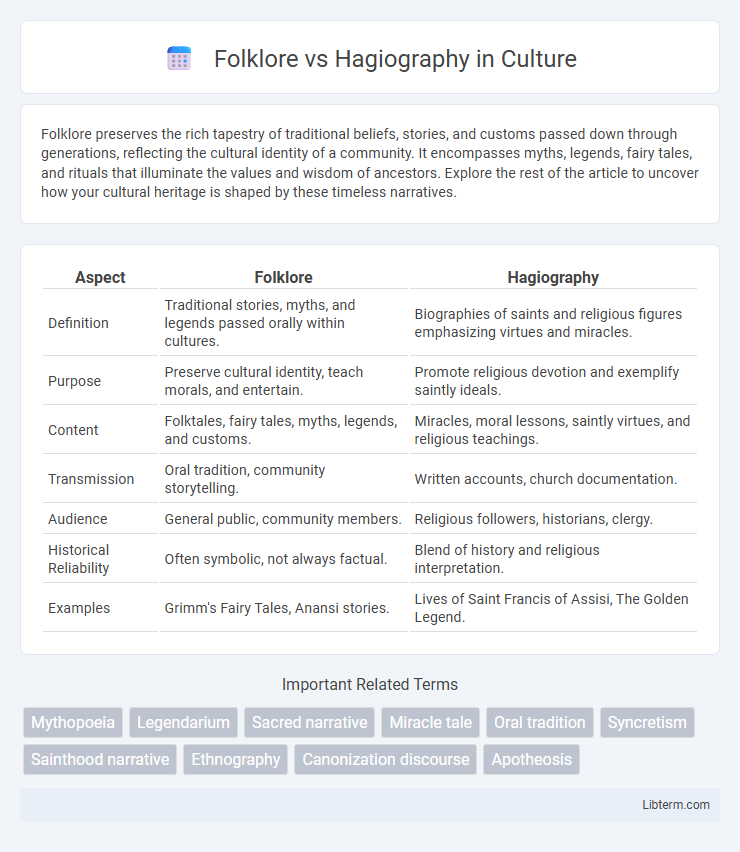Folklore preserves the rich tapestry of traditional beliefs, stories, and customs passed down through generations, reflecting the cultural identity of a community. It encompasses myths, legends, fairy tales, and rituals that illuminate the values and wisdom of ancestors. Explore the rest of the article to uncover how your cultural heritage is shaped by these timeless narratives.
Table of Comparison
| Aspect | Folklore | Hagiography |
|---|---|---|
| Definition | Traditional stories, myths, and legends passed orally within cultures. | Biographies of saints and religious figures emphasizing virtues and miracles. |
| Purpose | Preserve cultural identity, teach morals, and entertain. | Promote religious devotion and exemplify saintly ideals. |
| Content | Folktales, fairy tales, myths, legends, and customs. | Miracles, moral lessons, saintly virtues, and religious teachings. |
| Transmission | Oral tradition, community storytelling. | Written accounts, church documentation. |
| Audience | General public, community members. | Religious followers, historians, clergy. |
| Historical Reliability | Often symbolic, not always factual. | Blend of history and religious interpretation. |
| Examples | Grimm's Fairy Tales, Anansi stories. | Lives of Saint Francis of Assisi, The Golden Legend. |
Defining Folklore and Hagiography
Folklore encompasses the traditional beliefs, customs, stories, and practices passed orally within a culture, reflecting communal values and collective memory. Hagiography specifically refers to the biographies of saints and revered religious figures, often emphasizing their virtues, miracles, and divine connection. While folklore captures a broad spectrum of cultural expressions, hagiography serves a didactic and devotional purpose within religious contexts.
Historical Origins and Development
Folklore originates from oral traditions and communal storytelling, evolving through generations to preserve cultural beliefs, practices, and collective memory, while hagiography develops from written texts detailing the lives and virtues of saints primarily within religious contexts. Folklore's historical development is characterized by its diverse regional variations and adaptive nature, reflecting social values and historical events in a flexible narrative form. In contrast, hagiography has a more structured origin rooted in ecclesiastical authorities, often serving didactic purposes by promoting moral exemplars and reinforcing institutional religious identity.
Key Characteristics and Features
Folklore encompasses traditional stories, customs, and beliefs passed orally within communities, often featuring mythical heroes, cultural values, and collective experiences. Hagiography specifically refers to the biographies of saints and religious figures designed to inspire faith, emphasizing miracles, moral virtues, and divine intervention. Unlike folklore, hagiographies serve doctrinal purposes and are typically written with authoritative religious intent, reflecting historical and theological accuracy to varying degrees.
Purposes and Functions in Society
Folklore serves to preserve cultural heritage, transmit collective values, and entertain through traditional stories, myths, and customs, reinforcing community identity and social cohesion. Hagiography functions to inspire devotion, legitimize religious authority, and promote moral virtues by chronicling the lives and miracles of saints and holy figures. Both forms shape societal beliefs but folklore emphasizes cultural continuity while hagiography focuses on spiritual edification and ecclesiastical influence.
Narrative Structures and Storytelling Techniques
Folklore employs organic narrative structures characterized by collective authorship, oral transmission, and iterative modifications, emphasizing themes from everyday life and cultural values. Hagiography uses formalized storytelling techniques with fixed frameworks centered on the lives and miracles of saints, aiming to inspire devotion and reinforce religious ideology. Both genres utilize symbolic motifs, but folklore prioritizes adaptability and communal identity, while hagiography emphasizes doctrinal consistency and sanctity.
Sources and Methods of Transmission
Folklore relies on oral traditions, communal storytelling, and cultural rituals to transmit narratives across generations, often evolving with each retelling. Hagiography depends on written records, including saintly biographies, official church documents, and ecclesiastical texts, emphasizing doctrinal accuracy and moral lessons. The transmission of folklore is dynamic and fluid, while hagiographic methods prioritize preservation, standardization, and authoritative validation of spiritual accounts.
Portrayal of Heroes, Saints, and Supernatural Elements
Folklore often portrays heroes with human flaws and supernatural elements that emphasize cultural values and collective imagination, while hagiography idealizes saints, highlighting their divine virtues and miracles to inspire spiritual devotion. Heroes in folklore are typically complex characters engaged in morally ambiguous quests, whereas saints in hagiographies are depicted as paragons of holiness, overcoming trials through faith and divine intervention. Supernatural elements in folklore serve as narrative devices to explain natural phenomena or moral lessons, contrasting with hagiography's focus on miraculous events that confirm the saint's sanctity and divine favor.
Influence on Culture and Collective Memory
Folklore shapes culture and collective memory through oral traditions, myths, and legends that reflect societal values and historical experiences, preserving communal identity across generations. Hagiography influences culture by promoting the virtues and miracles of saints, reinforcing religious beliefs and moral frameworks within communities. Both forms contribute to collective memory by transmitting shared narratives, though folklore often emphasizes cultural heritage while hagiography underscores spiritual exemplars.
Critical Approaches and Academic Perspectives
Critical approaches to folklore and hagiography emphasize their distinct functions: folklore conveys communal beliefs and cultural values through oral traditions, while hagiography serves to promote religious ideals by documenting saints' lives. Academic perspectives analyze folklore using ethnographic methods to understand societal norms, whereas hagiography is examined through theological and historical lenses to explore spiritual narratives and institutional agendas. Both fields require interdisciplinary study to evaluate their roles in shaping collective memory and identity.
Contemporary Relevance and Adaptations
Folklore and hagiography continue to shape contemporary culture through adaptations in literature, film, and digital media, reflecting societal values and identity. Folklore's adaptability allows it to evolve with modern narratives, influencing popular genres like fantasy and horror, while hagiography maintains religious and moral instruction by venerating saints' lives. The juxtaposition of these traditions reveals enduring human fascination with myth, morality, and communal memory in contemporary storytelling.
Folklore Infographic

 libterm.com
libterm.com